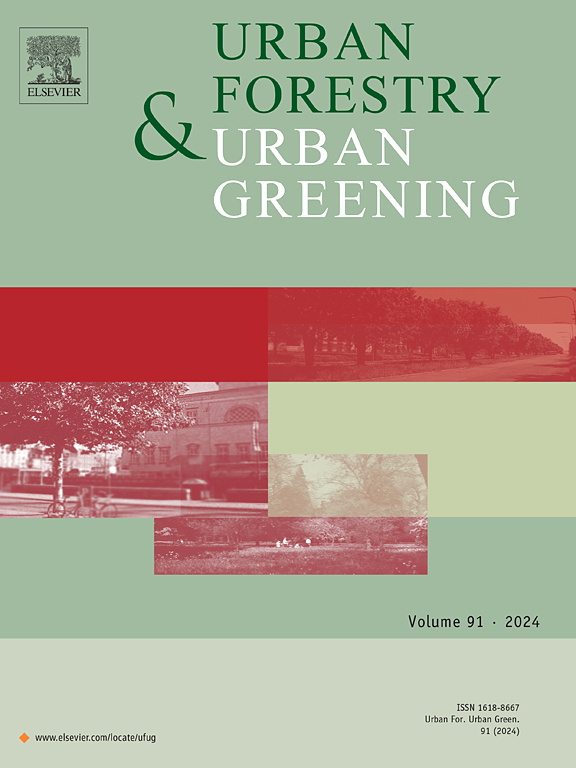Allometric equations underestimate woody volumes of large solitary trees outside forests
IF 6
2区 环境科学与生态学
Q1 ENVIRONMENTAL STUDIES
引用次数: 0
Abstract
Large solitary trees (LSTs) represent important wood volumes and carbon stocks outside forests. However, quantification remains difficult as most allometric relationships have been developed using trees in forests. Here, we explore the volumetric assessment of aboveground woody biomass of LSTs outside forests and compare them to forest trees. Using terrestrial laser scanning, we captured detailed 3D point clouds of 215 solitary trees for three widely distributed species, i.e. Quercus robur, Tilia sp. & Fraxinus excelsior, across nine cities in temperate Europe. Leaf-off lidar point clouds were processed using a quantitative structure model (QSM) to estimate the aboveground volumes and develop new species-specific allometric volume equations for solitary trees. Our findings show that the woody volumes of LSTs estimated by QSMs are, on average, 83 % higher than those predicted by species-specific allometric equations tailored to forest trees of similar height and diameter at breast height. To validate this discrepancy, we applied the same laser scanning and modeling methods to both LSTs and forest trees. Regression analysis confirmed that LSTs have significantly greater woody volumes than forest trees. However, this difference diminishes with increasing height, resulting in converging volumes in the tallest height class. Our results highlight the substantial carbon storage and wood volume potential of LSTs in both urban and rural areas, and underpin the urgent need for dedicated allometric volume equations tailored specifically to large solitary trees.
异速生长方程低估了森林外大型单生树木的木材体积
大型单生树(LSTs)是森林外重要的木材量和碳储量。然而,量化仍然很困难,因为大多数异速生长关系是利用森林中的树木发展起来的。本文探讨了林外LSTs地上木质生物量的体积评估,并将其与森林树木进行了比较。利用地面激光扫描技术,我们捕获了3种分布广泛的树种,即栎、椴等,共215棵孤树的详细三维点云。在欧洲温带的九座城市中发现了黄曲柳。利用定量结构模型(quantitative structure model, QSM)对叶片激光雷达点云进行了处理,估算了孤树的地上体积,并建立了新的物种特异性异速生长体积方程。我们的研究结果表明,QSMs估计的LSTs的木材体积平均比针对胸高相似高度和直径的森林树木量身定制的物种特异性异速生长方程预测的木材体积高83 %。为了验证这种差异,我们对lst和森林树木应用了相同的激光扫描和建模方法。回归分析证实,LSTs的木本体积明显大于森林乔木。然而,这种差异随着高度的增加而减小,导致最高高度类别的体积趋同。我们的研究结果强调了城市和农村地区LSTs的大量碳储存和木材体积潜力,并支持迫切需要专门针对大型孤立树的专用异速体积方程。
本文章由计算机程序翻译,如有差异,请以英文原文为准。
求助全文
约1分钟内获得全文
求助全文
来源期刊

Urban Forestry & Urban Greening
FORESTRY-
CiteScore
11.70
自引率
12.50%
发文量
289
审稿时长
70 days
期刊介绍:
Urban Forestry and Urban Greening is a refereed, international journal aimed at presenting high-quality research with urban and peri-urban woody and non-woody vegetation and its use, planning, design, establishment and management as its main topics. Urban Forestry and Urban Greening concentrates on all tree-dominated (as joint together in the urban forest) as well as other green resources in and around urban areas, such as woodlands, public and private urban parks and gardens, urban nature areas, street tree and square plantations, botanical gardens and cemeteries.
The journal welcomes basic and applied research papers, as well as review papers and short communications. Contributions should focus on one or more of the following aspects:
-Form and functions of urban forests and other vegetation, including aspects of urban ecology.
-Policy-making, planning and design related to urban forests and other vegetation.
-Selection and establishment of tree resources and other vegetation for urban environments.
-Management of urban forests and other vegetation.
Original contributions of a high academic standard are invited from a wide range of disciplines and fields, including forestry, biology, horticulture, arboriculture, landscape ecology, pathology, soil science, hydrology, landscape architecture, landscape planning, urban planning and design, economics, sociology, environmental psychology, public health, and education.
 求助内容:
求助内容: 应助结果提醒方式:
应助结果提醒方式:


